Abstract
A large number of iron-chelating compounds (siderophores) were isolated from supernatants of iron-deficient cultures of a mold isolate, subsequently identified as Aspergillus ochraceous . Siderophores in their iron chelate form were purified to homogeneity by using Bio-Gel P2, silica gel, and C-18 bonded silica gel (reverse-phase) columns. Most of these compounds, as identified by 1H and 13C nuclear magnetic resonance spectroscopy and X-ray crystallography, belong to the ferrichrome family. The organism produces ferrirubin and ferrichrysin as the predominant and the second major compound (62 and 15% of the total siderophores), respectively. Ferrichrysin appears as the first siderophore in the medium on day 2 of growth. Several of the other siderophores are novel and ranged in quantities from 0.2 to 5% of the total. The trivial names asperchrome A, B1, B2, C, D1, D2, and D3 are proposed for these novel compounds, which are all members of the ferrichrome family, and all but the first one contain a common Orn1 - Orn2 - Orn3 - Ser1 -Ser2-Gly cyclic hexapeptide ring with three dissimilar ornithyl delta-N-acyl groups. Another compound which appeared late in the growth period was similar to fusarinine C ( fusigen ). All of these compounds showed growth factor activity to various extents in bioassays with Arthrobacter flavescens Jg-9. None of these compounds showed antibacterial activity against Escherichia coli or Bacillus megaterium.
Full text
PDF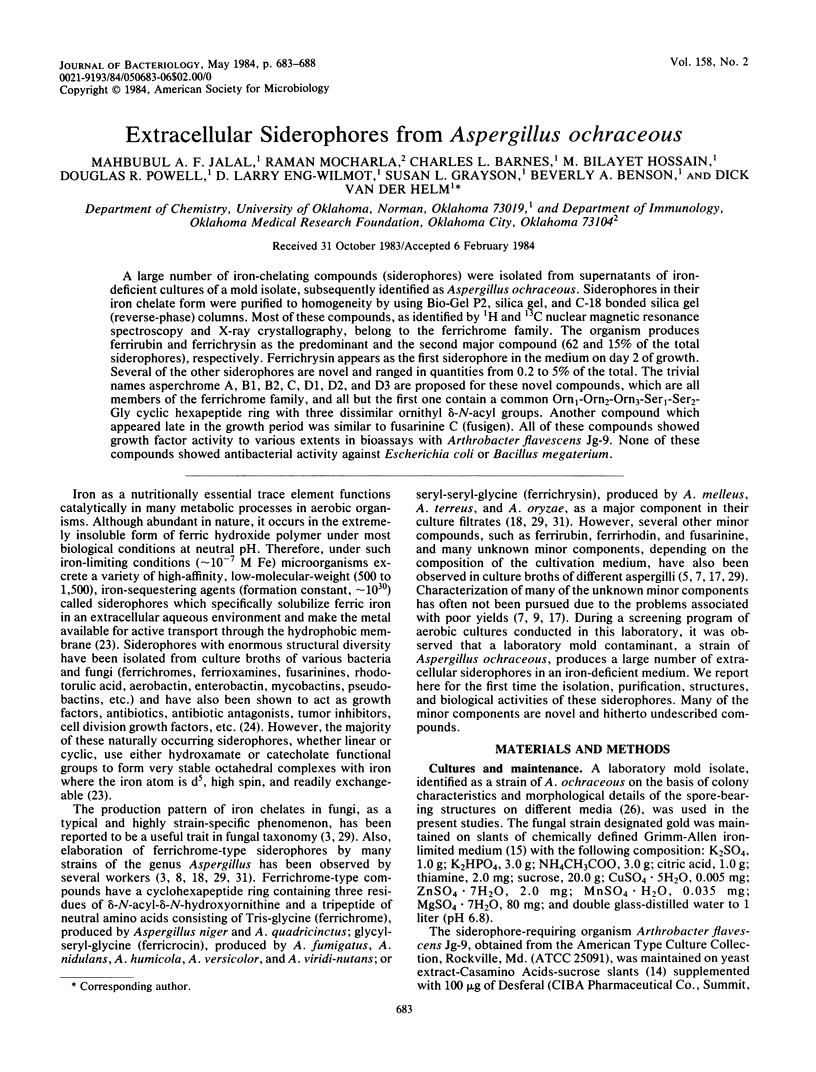
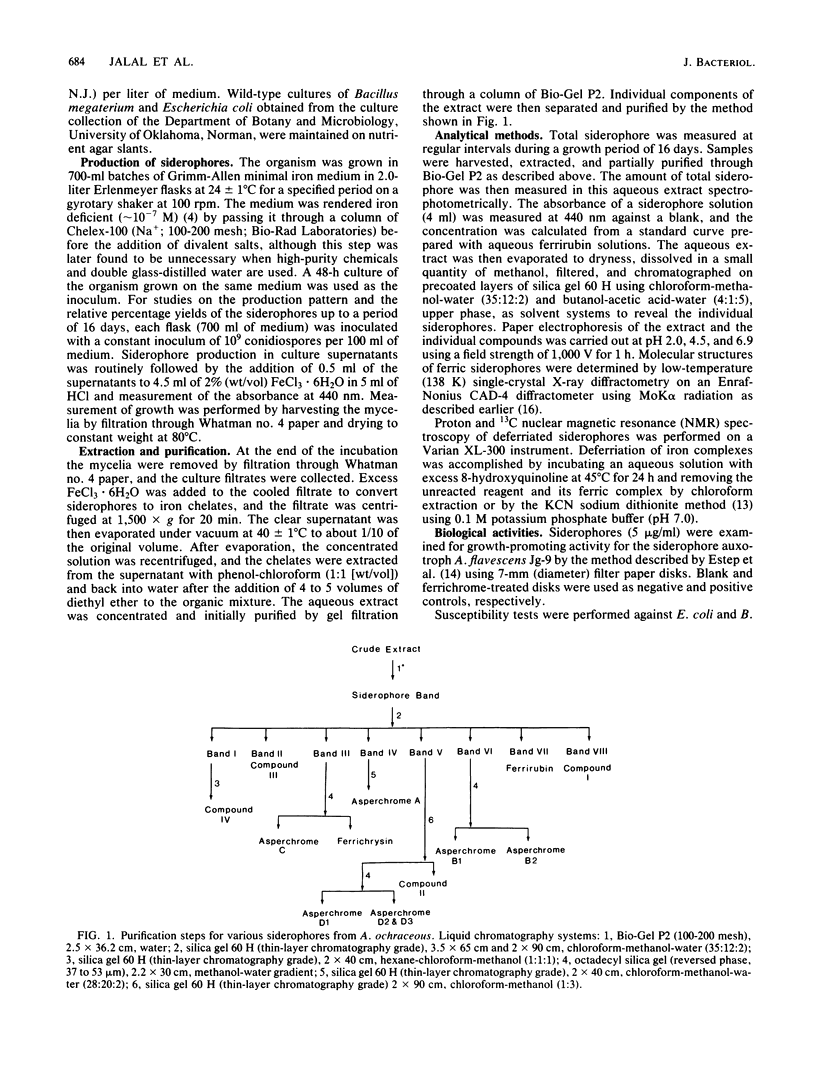
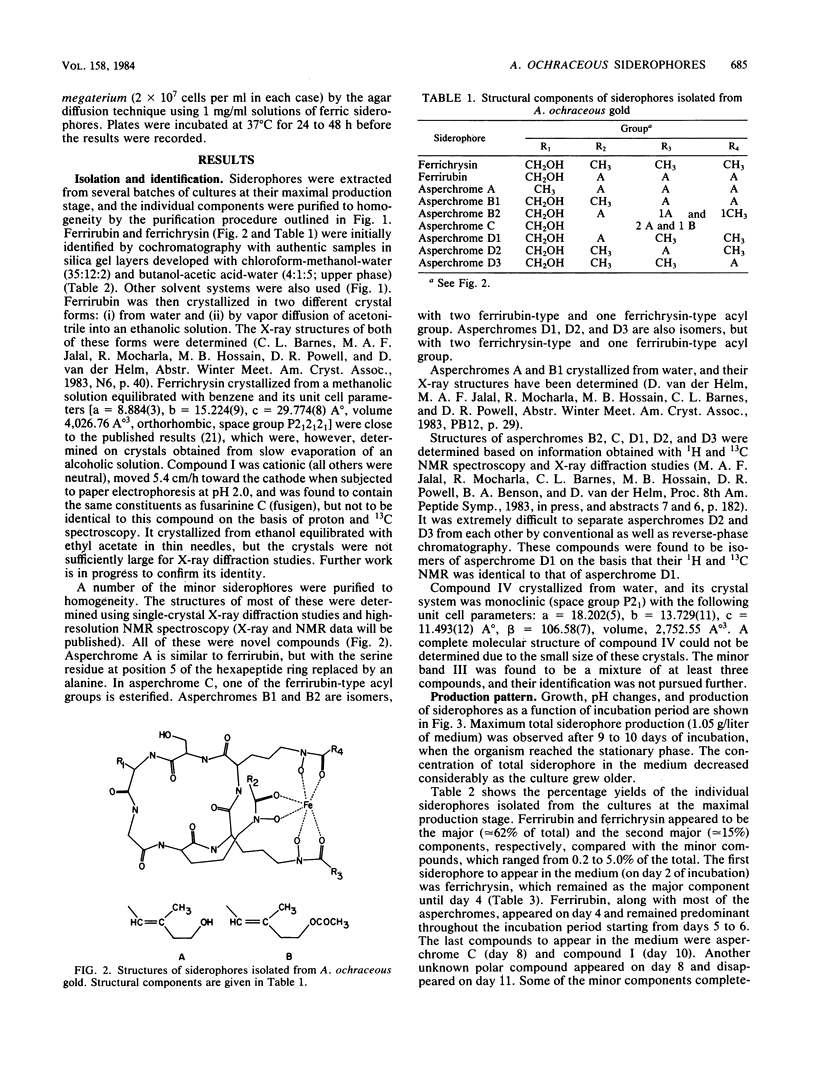
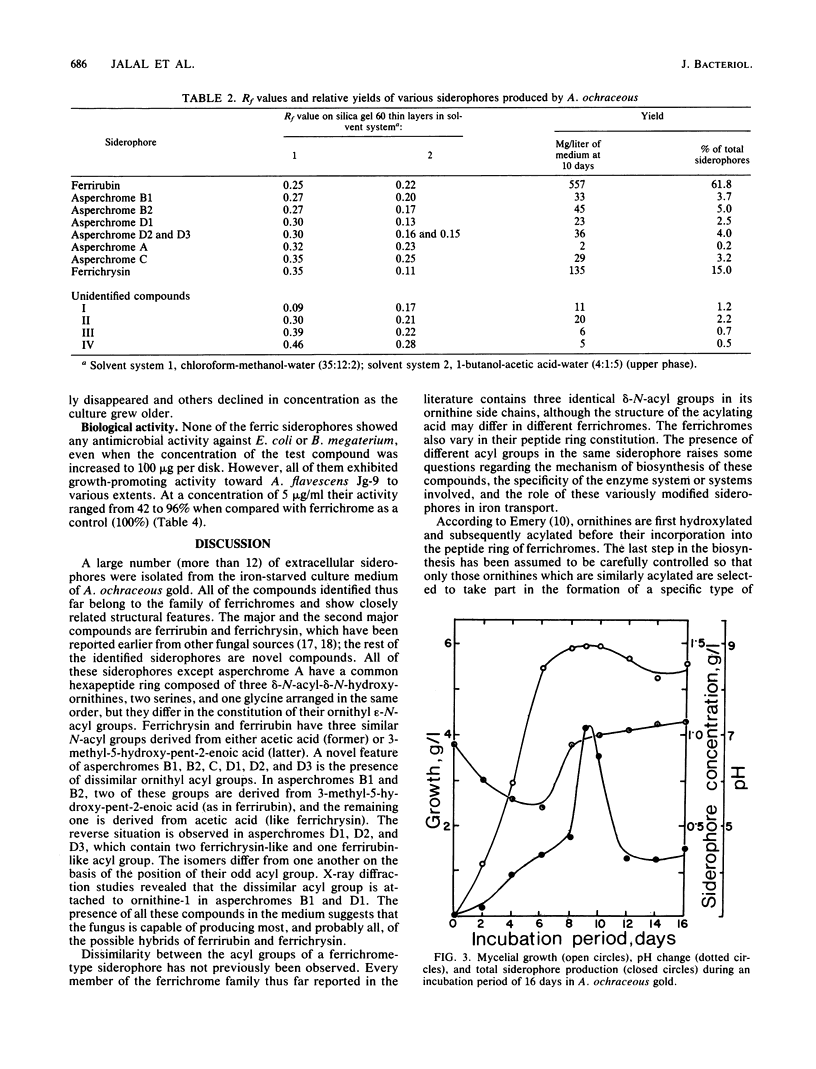
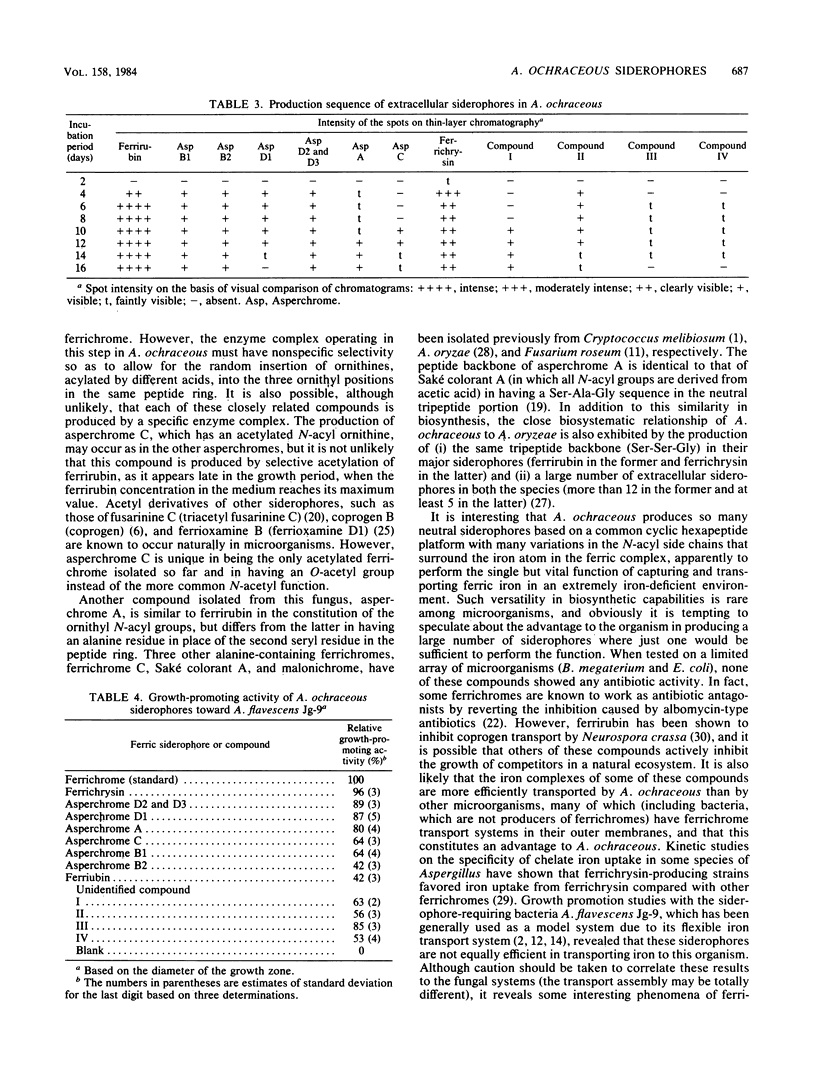
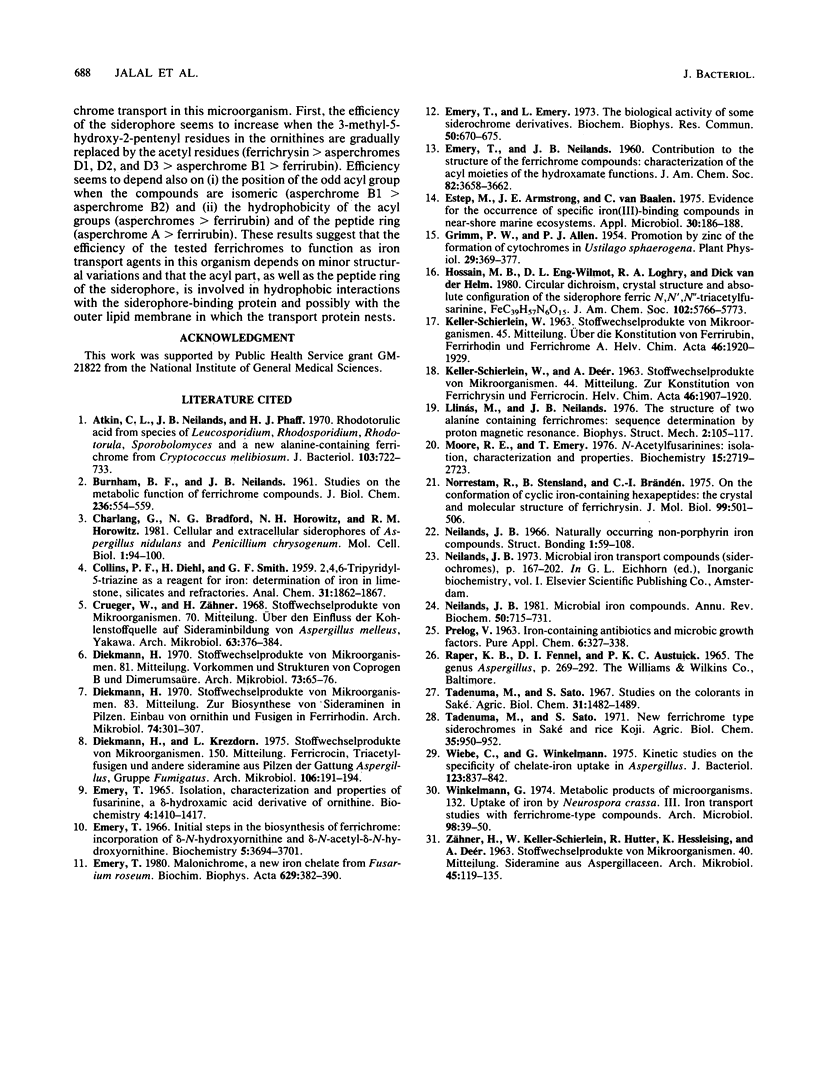
Selected References
These references are in PubMed. This may not be the complete list of references from this article.
- Atkin C. L., Neilands J. B., Phaff H. J. Rhodotorulic acid from species of Leucosporidium, Rhodosporidium, Rhodotorula, Sporidiobolus, and Sporobolomyces, and a new alanine-containing ferrichrome from Cryptococcus melibiosum. J Bacteriol. 1970 Sep;103(3):722–733. doi: 10.1128/jb.103.3.722-733.1970. [DOI] [PMC free article] [PubMed] [Google Scholar]
- BURNHAM B. F., NEILANDS J. B. Studies on the metabolic function of the ferrichrome compounds. J Biol Chem. 1961 Feb;236:554–559. [PubMed] [Google Scholar]
- Charlang G., Ng B., Horowitz N. H., Horowitz R. M. Cellular and extracellular siderophores of Aspergillus nidulans and Penicillium chrysogenum. Mol Cell Biol. 1981 Feb;1(2):94–100. doi: 10.1128/mcb.1.2.94. [DOI] [PMC free article] [PubMed] [Google Scholar]
- Crueger W., Zähner H. Stoffwechselprodukte von Mikroorganismen. 70. Uber den Einfluss der Kohlenstoffquelle auf die Sideraminbildung von Aspergillus melleus Yukawa. Arch Mikrobiol. 1968;63(4):376–384. [PubMed] [Google Scholar]
- Diekmann H., Krezdorn E. Stoffwechselprodukte von Mikroorganismen 150. Mitteilung. Ferricrocin, Triacetylfusigen und andere Sideramine aus Pilzen der Gattung Aspergillus, Gruppe Fumigatus. Arch Microbiol. 1975 Dec 31;106(3):191–194. doi: 10.1007/BF00446522. [DOI] [PubMed] [Google Scholar]
- Diekmann H. Stoffwechselprodukte von Mikroorganismen. 81. Vorkommen und Strukturen von Coprogen B und Dimerumsäure. Arch Mikrobiol. 1970;73(1):65–76. [PubMed] [Google Scholar]
- Emery T. F. Initial steps in the biosynthesis of ferrichrome. Incorporation of delta-N-hydroxyornithine and delta-N-acetyl-delta-N-hydroxyornithine. Biochemistry. 1966 Nov;5(11):3694–3701. doi: 10.1021/bi00875a045. [DOI] [PubMed] [Google Scholar]
- Emery T., Emery L. The biological activity of some siderochrome derivatives. Biochem Biophys Res Commun. 1973 Feb 5;50(3):670–675. doi: 10.1016/0006-291x(73)91296-5. [DOI] [PubMed] [Google Scholar]
- Emery T. Isolation, characterization, and properties of fusarinine, a delta-hydroxamic acid derivative of ornithine. Biochemistry. 1965 Jul;4(7):1410–1417. doi: 10.1021/bi00883a028. [DOI] [PubMed] [Google Scholar]
- Emery T. Malonichrome, a new iron chelate from Fusarium roseum. Biochim Biophys Acta. 1980 May 7;629(2):382–390. doi: 10.1016/0304-4165(80)90110-5. [DOI] [PubMed] [Google Scholar]
- Estep M., Armstrong J. E., Van Baalen C. Evidence for the occurrence of specific iron (III)-binding compounds in near-shore marine ecosystems. Appl Microbiol. 1975 Aug;30(2):186–188. doi: 10.1128/am.30.2.186-188.1975. [DOI] [PMC free article] [PubMed] [Google Scholar]
- Grimm P. W., Allen P. J. Promotion by Zinc of the Formation of Cytochromes in Ustilago sphaerogena. Plant Physiol. 1954 Jul;29(4):369–377. doi: 10.1104/pp.29.4.369. [DOI] [PMC free article] [PubMed] [Google Scholar]
- Llinás M., Neilands J. B. The structure of two alanine containing ferrichromes: sequence determination by proton magnetic resonance. Biophys Struct Mech. 1976 Aug 23;2(2):105–117. doi: 10.1007/BF00863704. [DOI] [PubMed] [Google Scholar]
- Moore R. E., Emery T. Nalpha-acetylfusarinines: isolation, characterization, and properties. Biochemistry. 1976 Jun 29;15(13):2719–2723. doi: 10.1021/bi00658a001. [DOI] [PubMed] [Google Scholar]
- Neilands J. B. Microbial iron compounds. Annu Rev Biochem. 1981;50:715–731. doi: 10.1146/annurev.bi.50.070181.003435. [DOI] [PubMed] [Google Scholar]
- Norrestam R., Stensland B., Brändén C. I. On the conformation of cyclic iron-containing hexapeptides: the crystal and molecular structure of ferrichrysin. J Mol Biol. 1975 Dec 15;99(3):501–506. doi: 10.1016/s0022-2836(75)80141-0. [DOI] [PubMed] [Google Scholar]
- Wiebe C., Winkelmann G. Kinetic studies on the specificity of chelate-iron uptake in Aspergillus. J Bacteriol. 1975 Sep;123(3):837–842. doi: 10.1128/jb.123.3.837-842.1975. [DOI] [PMC free article] [PubMed] [Google Scholar]
- Winkelmann G. Metabolic products of microorganisms. 132. Uptake of iron by Neurospora crassa. 3. Iron transport studies with ferrichrome-type compounds. Arch Mikrobiol. 1974 Jun 7;98(1):39–50. [PubMed] [Google Scholar]


